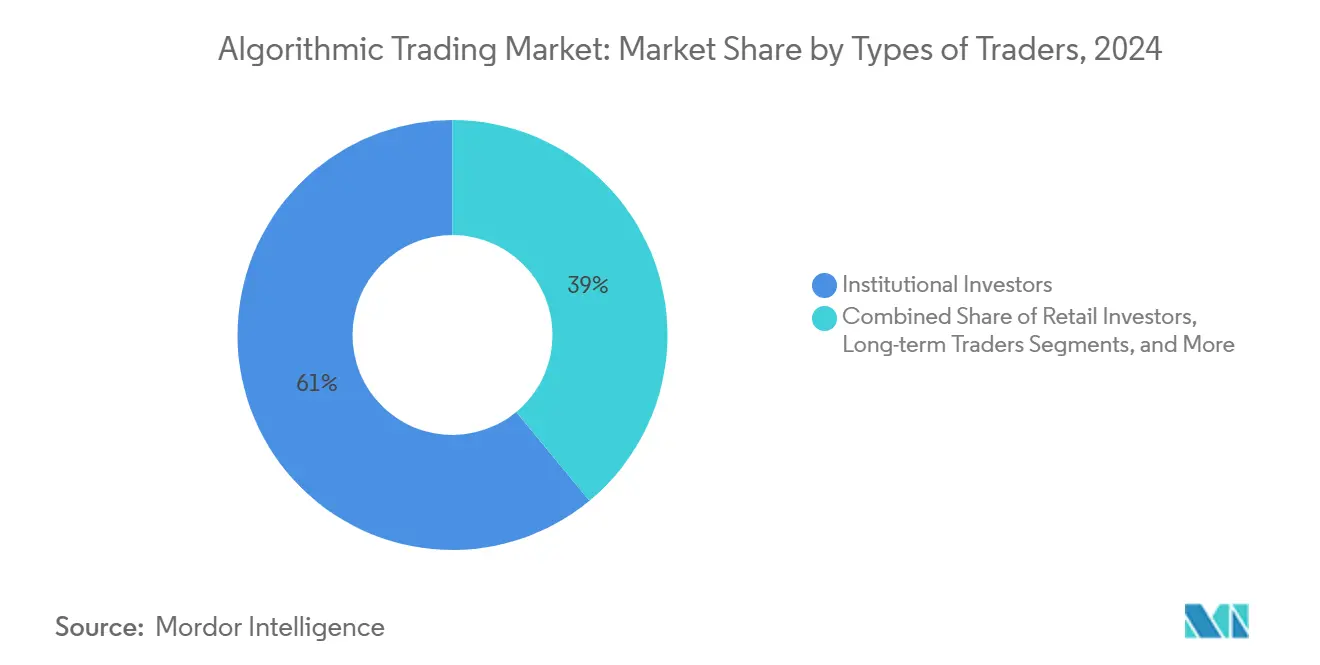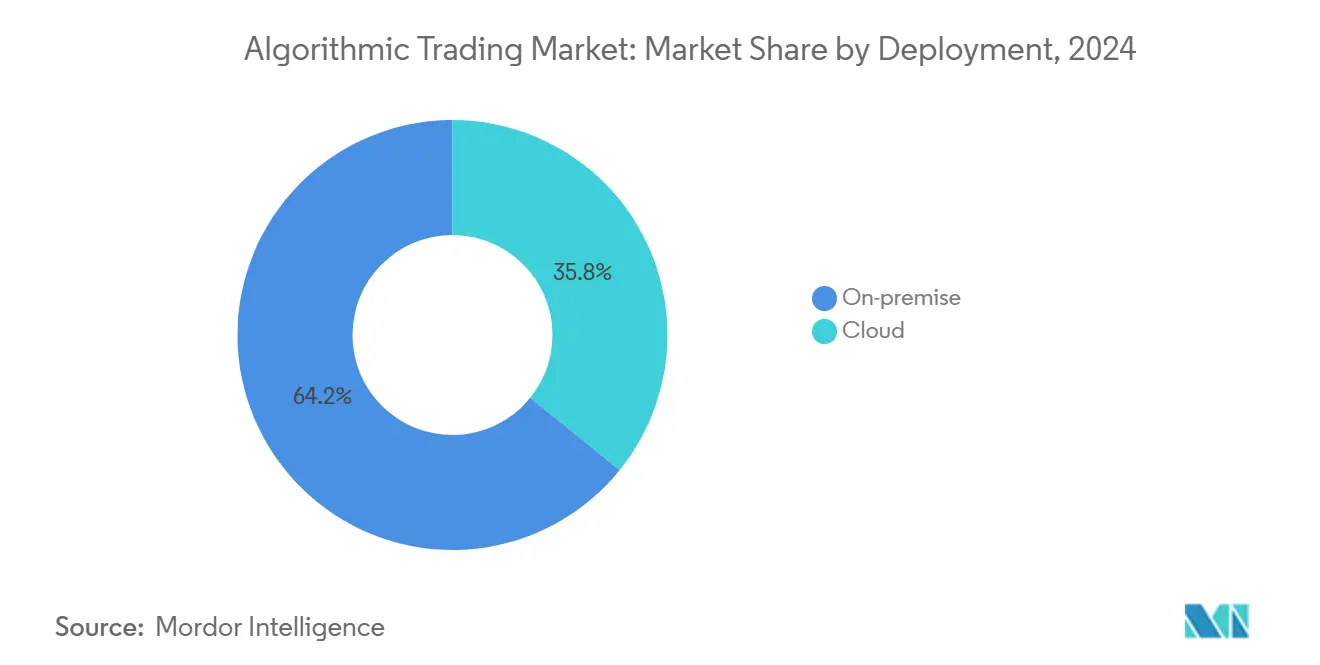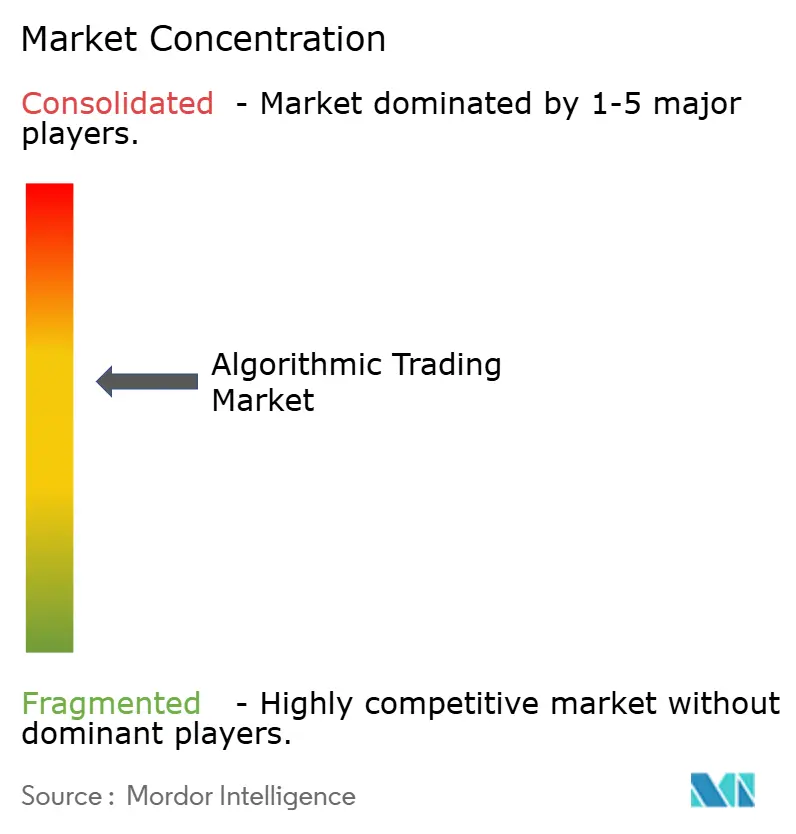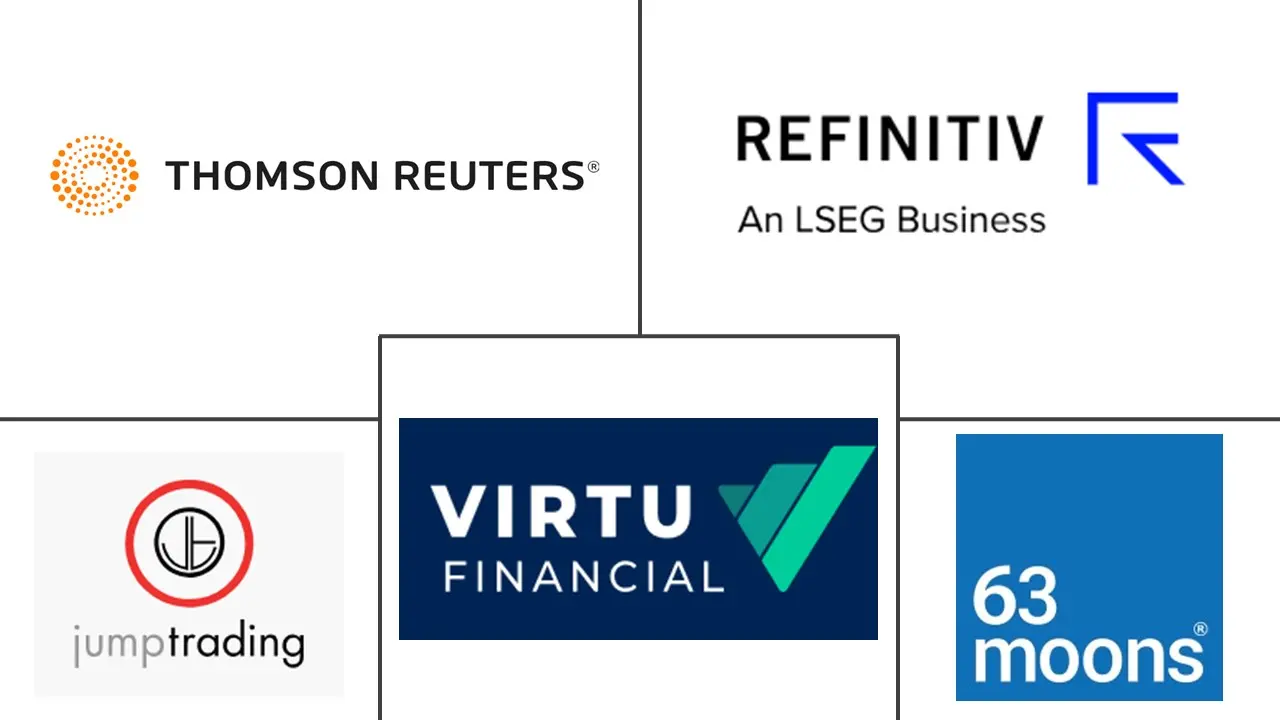Algorithmic Trading Market Size and Share

Algorithmic Trading Market Analysis by Mordor Intelligence
The Algorithmic Trading Market size is estimated at USD 18.73 billion in 2025, and is expected to reach USD 28.44 billion by 2030, at a CAGR of 8.71% during the forecast period (2025-2030).
Uptake is accelerating as artificial-intelligence techniques boost execution quality and allow traders to cope with volatile conditions. Exchanges in North America lead innovation, while robust demand from Asia-Pacific widens the addressable user base. Institutional desks still anchor volumes, yet retail access to low-code automation is reshaping competitive dynamics. Services linked to model design and compliance are outpacing platform revenues, counterbalancing heavier spending on secure on-premise infrastructure. At the same time, cloud latency is falling fast enough to tempt smaller firms that once sat on the sidelines.
Key Report Takeaways
- By trader type, institutional investors held 61% of the algorithmic trading market share in 2024; retail investors are projected to advance at a 10.8% CAGR through 2030.
- By component, solutions captured 73.5% revenue share algorithmic trading market in 2024, while services are forecast to grow at 11.6% CAGR to 2030.
- By deployment, on-premise systems commanded 64.2% of the algorithmic trading market size in 2024; cloud deployment is set to expand at a 13.4% CAGR.
- By organisation size, large enterprises retained 68.7% share of the algorithmic trading market in 2024, whereas SMEs are on track for a 12.9% CAGR.
- By geography, North America led with a 47.3% share in 2024; Asia-Pacific is the fastest-growing region, forecast at a 12.4% CAGR between 2025-2030.
Global Algorithmic Trading Market Trends and Insights
Drivers Impact Analysis
| Driver | (~) % Impact on CAGR Forecast | Geographic Relevance | Impact Timeline |
|---|---|---|---|
| Rising demand for sub-millisecond order execution across US and Japanese equity venues | +2.1% | North America, Asia-Pacific (Japan) | Medium term (2-4 years) |
| Surging passive-investment AUM fuelling index-rebalance algos in Europe | +1.8% | Europe | Long term (≥ 4 years) |
| Expansion of crypto-exchange API liquidity pools in South-East Asia | +1.5% | Asia-Pacific (South-East Asia) | Medium term (2-4 years) |
| Consolidation of fragmented FX liquidity via multi-dealer platforms in ME and Africa | +1.2% | Middle East and Africa | Medium term (2-4 years) |
| Proliferation of AI-driven sentiment feeds (alt-data) in US large-cap trading | +1.7% | North America | Short term (≤ 2 years) |
| Regulatory push for best-execution (MiFID II, SEC Reg NMS modernisation) | +1.3% | Global, with emphasis on North America and Europe | Medium term (2-4 years) |
| Source: Mordor Intelligence | |||
Rising demand for sub-millisecond order execution
Latency competition in the algorithmic trading market has moved from microseconds to picoseconds in US and Japanese equities. Firms deploy field-programmable gate arrays and bespoke fibre routes to shave time, aiming to capture part of the USD 5 billion global value tied to latency arbitrage each year [1]Aquilina M., Budish E., O’Neill P., “Quantifying the high-frequency trading arms race,” bis.org. Litigation over patent rights underscores the strategic value of speed. Capital-intensive upgrades, however, tilt the advantages toward well-funded players and may heighten market concentration.
Surging passive-investment AUM fuelling index-rebalance algos
Global ETF assets touched USD 13.8 trillion in 2024 [2]State Street Global Advisors, “The ETF Impact Report 2024-2025,” ssga.com. Rebalancing flows trigger large, time-compressed orders that demand sophisticated algorithmic execution able to track benchmark weights without moving prices. Europe’s share of passive UCITS funds more than doubled over the past decade, intensifying the need for cross-asset models that minimise market impact while coping with complex correlations.
Expansion of crypto-exchange API liquidity pools
Standardised APIs on South-East Asian exchanges allow seamless integration with legacy trading stacks, inviting traditional desks to exploit digital-asset arbitrage in the algorithmic trading market. The forthcoming Markets in Crypto-Assets regime harmonises oversight and is expected to draw more institutional flow. Cross-asset algos increasingly scan correlations between tokens and listed futures, broadening the revenue mix for systematic funds.
Regulatory push for best-execution
The US SEC refreshed Regulation NMS in 2024 to sharpen price-improvement metrics [3]Securities and Exchange Commission, “Regulation NMS: Minimum Pricing Increments, Access Fees, and Transparency of Better Priced Orders,” sec.gov, while MiFID II keeps European venues focused on audit trails. Compliance demands have spurred demand for transparent algorithms that can evidence price-improvement logic, nudging slower desks toward automation.
Restraints Impact Analysis
| Restraint | (~) % Impact on CAGR Forecast | Geographic Relevance | Impact Timeline |
|---|---|---|---|
| Rising exchange colocation costs squeezing mid-tier prop desks | -0.9% | Global, with emphasis on North America and Europe | Medium term (2-4 years) |
| Instant loss of liquidity during "flash-crash" events | -0.7% | Global | Short term (≤ 2 years) |
| Stringent market-surveillance fines on HFT spoofing in EU | -0.5% | Europe, with spillover effects to North America | Medium term (2-4 years) |
| Data-feed latency differentials in emerging exchanges | -0.4% | Asia-Pacific, Middle East and Africa | Long term (≥ 4 years) |
| Source: Mordor Intelligence | |||
Rising exchange colocation costs squeezing mid-tier desks
Fee hikes such as the increase to USD 13,500 per month for 10 Gb ULL fibre at MIAX PEARL weigh on balance sheets and may force mid-sized proprietary shops to scale back. High entry costs protect incumbents but thin the competitive field, potentially reducing spread tightness in less-traded instruments.
Instant loss of liquidity during flash-crash events
Episodes of abrupt price collapse expose vulnerabilities when liquidity providers withdraw simultaneously. Studies link algorithmic herding to amplified volatility under stress. Traders now build kill switches and robust circuit breakers, but the residual risk still dampens adoption by cautious asset managers.
Segment Analysis
By Types of Traders: Retail investors disrupt institutional dominance
Institutional investors commanded 61% of the algorithmic trading market in 2024, anchored by deep capital and infrastructure. Retail traders, however, are growing fastest at a 10.8% CAGR as easy-to-use platforms replicate institutional toolkits. Brokerage portals now bundle strategy builders, order-routing algos, and back-testing libraries, lowering technical barriers. Educational initiatives reinforce adoption by boosting trust and demystifying automation. Regulatory bodies remain vigilant to ensure adequate safeguards for non-professional users.
Retail participation injects fresh order flow and fosters competitive quoting. Yet heavier retail turnover also magnifies the need for robust risk controls because crowd-sourced models can unintentionally converge. Brokerage analytics show rising preference for short-cycle strategies that exploit intraday micro-structure, often mirroring institutional scalping tactics. Over time, the influx of retail volumes can dilute traditional desk advantages in certain liquidity pockets.

Note: Segment shares of all individual segments available upon report purchase
By Component: Services outpace solutions growth
Solutions captured 73.5% of the algorithmic trading market share in 2024, bundling execution engines, analytics dashboards, and connectivity adapters. Still, the services segment is on an 11.6% CAGR trajectory, reflecting appetite for bespoke model tuning, regulatory reporting, and custom data integration. Clients increasingly outsource niche tasks such as reinforcement-learning policy calibration or post-trade venue analysis to specialist consultants, who combine financial engineering with domain-specific AI skills.
The rise in services in the algorithmic trading market is reinforced by rapid rule changes that require continual recoding. Firms lacking in-house quant bandwidth lean on advisory teams to maintain code bases, validate model risk, and conduct explainability audits. Coupled with the shift to cloud-native pipelines, service firms that master both DevOps and trading logic find a widening revenue pool.
By Deployment: Cloud adoption accelerates
On-premise installations held 64.2% of the algorithmic trading market size in 2024, owing to strict latency and data-sovereignty demands. Yet cloud deployments are growing at 13.4% CAGR as hyperscalers introduce deterministic latency zones and hardware accelerators. High-frequency shops can now spin up FPGA-equipped instances for back-tests, cutting research cycles from weeks to hours.
Latency-sensitive routing for US equities still prefers co-located racks, but strategy research, risk scenario analysis, and cross-asset simulations increasingly run in the cloud. Encryption-at-rest, confidential computing, and region-locked buckets satisfy regulators, removing earlier impediments. Smaller brokers gain an outsized benefit, accessing technology once reserved for global banks.

Note: Segment shares of all individual segments available upon report purchase
By Organization Size: SMEs embrace algorithmic trading
Large enterprises retained 68.7% share in 2024, yet SMEs posted the fastest 12.9% CAGR thanks to pay-per-use cloud resources and template-based code. Drag-and-drop frameworks let regional prop shops trade futures spreads or options gamma with minimal coding knowledge. This democratisation diversifies liquidity sources and can lower spreads on mid-cap securities.
Challenges remain: SMEs must tackle data-quality assurance, monitor model drift, and meet audit obligations. Providers respond with turnkey compliance layers that log every decision path, thereby reducing regulatory overheads. Over the forecast horizon, SME adoption is expected to lift overall volumes in emerging exchanges and niche derivatives.
Geography Analysis
North America contributed 47.3% of the global algorithmic trading market turnover in 2024. Regulatory clarity, a dense exchange network, and close integration between asset managers and technology vendors sustain growth. The SEC’s update to Regulation NMS raises transparency standards, reinforcing algorithmic execution as a compliance necessity. AI-based sentiment analytics already influence large-cap order books, while research into machine-learning midpoint indicators fosters novel liquidity-seeking strategies.
Asia-Pacific delivers the strongest momentum in the algorithmic trading market, projected at a 12.4% CAGR through 2030. Japan’s mature equity venue infrastructure supports picosecond experimentation, whereas China balances expansion with higher HFT fees aimed at curbing excess churn. South-East Asian crypto venues export standardised APIs, blending digital-asset liquidity with equities and FX workflows. India’s regulator is drafting guidelines to open algorithmic trading to a broader retail base while preserving systemic safeguards.
Europe occupies a pivotal position shaped by MiFID II. Stringent transparency and circuit-breaker obligations heighten demand for auditable code. Passive-investment flows dominate turnover, pushing providers to refine index-rebalance algos that mitigate tracking error. The European Central Bank’s stability review warns that high valuations could amplify risks when automated flows unwind, underscoring the need for scenario testing [4]European Central Bank, “Financial Stability Review 2024,” ecb.europa.eu. Multi-dealer FX portals in the Middle East and Africa begin to close historical liquidity gaps, inviting systematic funds to deploy cross-currency spreads previously deemed infeasible.

Competitive Landscape
Top Companies in Algorithmic Trading Market
Market rivalry in the algorithmic trading market is intense, yet race-to-zero-latency dynamics create high barriers for new entrants. Research shows the top six high-frequency firms capture more than 80% of “race wins” during latency arbitrage contests. Incumbents invest in microwave links and custom silicon, while fast-growing challengers focus on cloud-native AI pipelines that adapt strategies dynamically.
Strategic litigation around FPGA patents signals the commercial value of microstructure expertise. Partnerships such as Hudson River Trading’s tie-up with a major cloud provider illustrate an emerging playbook: rent elastic compute for research, reserve on-premise racks for production. White-space remains in cross-asset arbitrage linking crypto derivatives with listed futures, as well as ESG-aligned factor models that pull in satellite or alternative data.
Algorithmic Trading Industry Leaders
Thomson Reuters
Jump Trading LLC
Refinitiv Ltd
63 Moons Technologies Ltd
Virtu Financial Inc.
- *Disclaimer: Major Players sorted in no particular order

Recent Industry Developments
- May 2025: Mezzi introduced a real-time sentiment platform that parses financial text for trading signals.
- April 2025: Tradeweb recorded USD 509.7 million in Q1 revenue, up 24.6%, helped by newly integrated algorithmic tools.
- March 2025: Hudson River Trading created a market-structure analytics unit to refine execution architecture.
- February 2025: London Stock Exchange Group highlighted rising algorithmic execution uptake following its acquisition of r8fin.
- January 2025: Jump Trading set up a low-frequency statistical-arbitrage team in Hong Kong to broaden Asia-Pacific strategies.
Research Methodology Framework and Report Scope
Market Definitions and Key Coverage
Mordor Intelligence defines the algorithmic trading market as the aggregated global revenue generated from platforms, software tools, and associated services that automatically execute buy-and-sell orders across listed financial instruments using pre-programmed instructions related to price, time, or volume. The study covers enterprise-grade and cloud-hosted systems adopted by institutional desks and technologically advanced retail brokers during 2023-2030.
Scope exclusions include proprietary in-house algorithms that are never commercialized and one-off scripts built by hobbyist traders, which are outside this scope.
Segmentation Overview
- By Types of Traders
- Institutional Investors
- Retail Investors
- Long-term Traders
- Short-term Traders
- By Component
- Solutions
- Platforms
- Software Tools
- Services
- Solutions
- By Deployment
- Cloud
- On-premise
- By Organisation Size
- Small and Medium Enterprises
- Large Enterprises
- By Geography
- North America
- United States
- Canada
- Mexico
- South America
- Brazil
- Argentina
- Chile
- Peru
- Rest of South America
- Europe
- Germany
- United Kingdom
- France
- Italy
- Spain
- Rest of Europe
- Asia-Pacific
- China
- Japan
- South Korea
- India
- Australia
- New Zealand
- Rest of Asia-Pacific
- Middle East and Africa
- United Arab Emirates
- Saudi Arabia
- Turkey
- South Africa
- Rest of Middle East and Africa
- North America
Detailed Research Methodology and Data Validation
Primary Research
Mordor analysts interview sell-side technologists, buy-side quant leads, exchange connectivity providers, and reg-tech consultants across North America, Europe, and Asia-Pacific. These interactions clarify average ticket sizes, latency premiums, and cloud-migration timelines that secondary data alone cannot reveal, and they validate model assumptions before sign-off.
Desk Research
Our analysts begin with publicly available filings from major exchanges, quarterly disclosures from leading brokerage groups, Bank for International Settlements statistics, and region-wise trade-execution volumes published by regulators such as the SEC and ESMA. Trade associations like the Futures Industry Association and the World Federation of Exchanges help us benchmark contract volumes and fee structures. We enrich those inputs with macro indicators from the IMF and OECD and selected paid databases, including Dow Jones Factiva for deal news, D&B Hoovers for vendor financials, and Questel for AI-trading patent activity. The sources listed illustrate the breadth of desk work; many other datasets are consulted to cross-check figures and assumptions.
Market-Sizing & Forecasting
We employ a top-down build that reconstructs the global spend pool from exchange-reported electronic execution volumes, weighted average commission rates, and technology spend ratios, followed by selective bottom-up checks using vendor revenue roll-ups and sampled average selling price multiplied by seat counts. Key variables include 1) electronic share of total equities and FX turnover, 2) average commission compression per asset class, 3) cloud penetration in order-management workloads, 4) regional latency-premium differentials, and 5) AI-enhanced hit-rate improvements. Forecasts rely on multivariate regression that links these drivers to historical spend and tests scenarios for macro volatility and regulatory change. Data gaps in vendor disclosures are bridged with normalized industry benchmarks gathered during primary interviews.
Data Validation & Update Cycle
Outputs pass variance checks against independent benchmarks, after which senior reviewers look for outliers. We refresh each model annually and trigger interim updates when material events, such as fee-structure shifts or major outages, alter underlying assumptions. Before publishing, an analyst reruns the dataset to ensure clients receive the latest view.
Why Mordor's Algorithmic Trading Baseline Commands Reliability
Published estimates often diverge because research houses apply different asset-class mixes, price assumptions, and refresh cadences.
Key gap drivers include some publishers bundling in-house hedge-fund spend or excluding service revenues; others extend forecasts with optimistic AI-adoption curves or convert currencies at spot rather than average annual rates, which skews values when the dollar fluctuates. Mordor reports only commercial revenues, applies blended annual exchange rates, and updates models every twelve months, keeping our baseline balanced and repeatable.
Benchmark comparison
| Market Size | Anonymized source | Primary gap driver |
|---|---|---|
| USD 18.73 B (2025) | Mordor Intelligence | - |
| USD 21.06 B (2024) | Global Consultancy A | Includes crypto-exchange infrastructure and applies aggressive AI-uplift factor |
| USD 18.8 B (2024) | Industry Journal B | Counts trade-execution software only, omits managed services and support fees |
In sum, Mordor's disciplined scope selection, variable tracking, and yearly refresh give decision-makers a dependable, transparent starting point while illuminating why rival figures may swing wider than market reality.
Key Questions Answered in the Report
What is the projected size of the algorithmic trading market by 2030?
The market is forecast to reach USD 28.44 billion by 2030, growing at an 8.71% CAGR.
Which region is growing fastest in algorithmic trading adoption?
Asia-Pacific is expected to expand at a 12.4% CAGR between 2025-2030, outpacing all other regions.
Why are services outpacing software solutions in growth?
Regulatory complexity and the need for bespoke model optimisation are driving an 11.6% CAGR for specialised services.
How are rising colocation fees affecting smaller trading firms?
Higher infrastructure costs squeeze mid-tier proprietary desks, potentially reducing competitive diversity and end-investor spread benefits.
What role does artificial intelligence play in modern algorithms?
AI enhances pattern recognition and sentiment analysis, enabling faster signal generation and adaptive execution across asset classes.
Are cloud deployments viable for latency-sensitive strategies?
Research and back-testing increasingly rely on cloud resources; however, production-grade ultra-low-latency strategies still favour co-located on-premise setups for microsecond advantages.



